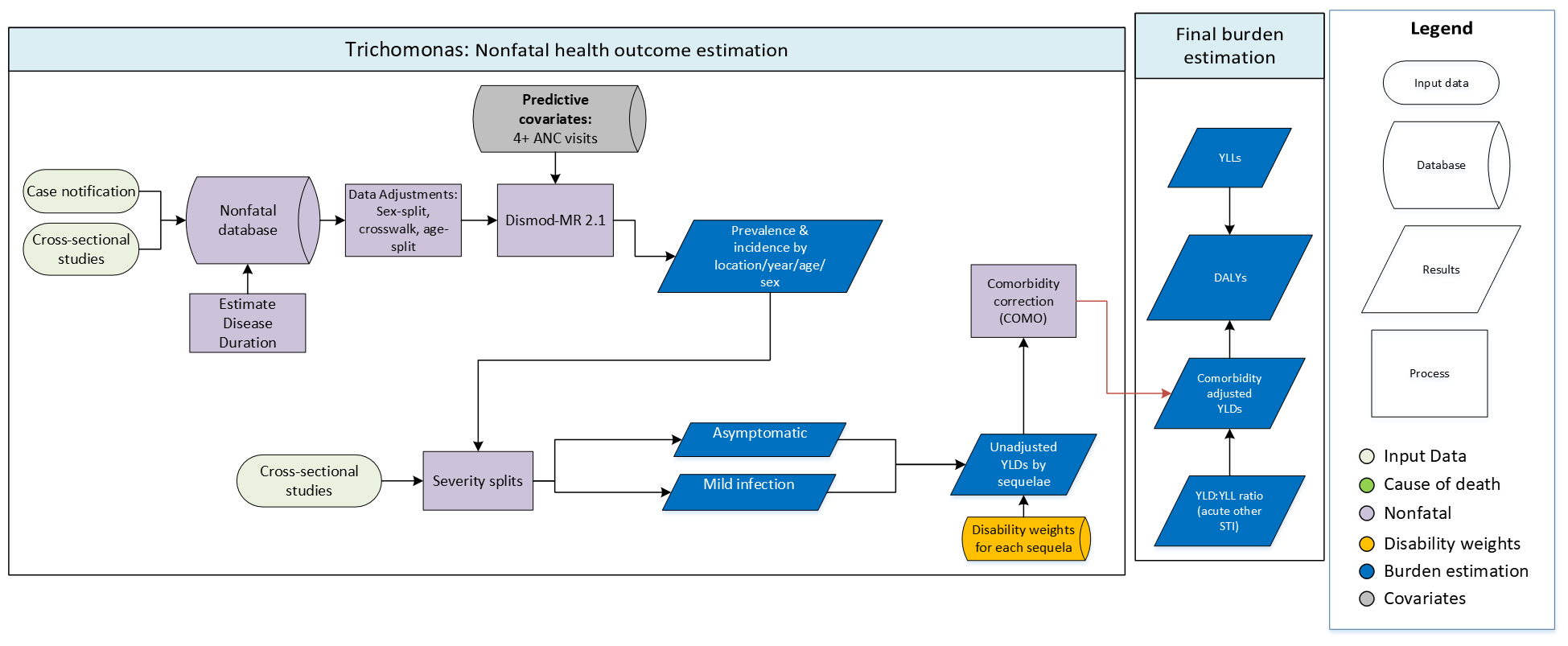Stroke

- Severity splits (chronic)
- Severity splits (acute)
- Split non-subtype-specific survey data
- 28 day survivorship
- Ratios of acute ischemic, chronic ischemic, acute hemorrhagic, and chronic hemorrhagic CSMR
- Scaled DisMod proportion models (chronic)
- Scaled DisMod proportion models (acute)
- CoDCorrect
- DisMod-MR 2.1
- Comorbidity correction (COMO)
Tetanus

- Apply % mild, moderate/severe impairment due to neonatal tetanus
- MR-BRT sex-specific model
- Death rate = deaths / population
- Incidence = death rate / CFR
- Incidence of survival from neonatal tetanus - incidence of neonatal tetanus * (1 - CFR)
- Prevalence = incidence * duration
- Assume all tetanus cases are severe
- Severity splits
- Severity splits as in neonatal encephalopathy
- Dismod-MR
- DisMod-MR age-specific model
- Comorbidity correction (COMO)
- DisMod-MR model
Trachoma

- Multiply proportion by blindness envelope
- Multiply proportion by low vision envelope
- Split into moderate and severe vision loss
- Squeeze into severity-specific vision loss envelope
- Comorbidity correction (COMO)
- Dismod-MR 2.1
Trichomonas: Nonfatal health outcome estimation

- Data Adjustments: sex-split, crosswalk, age-split
- Estimate Disease Duration
- Severity splits
- Dismod MR-2.1
- Comorbidity correction (COMO)
Trichuriasis

- Prepare data for ST-GPR
- Compute age-specific ratios; apply ratio to ST-GPR output
- Compute proportion of cases that belong to health states
- Apply health state proportions to overall hookworm envelope
- Estimate prevlanece of severe wasting due to trichuriasis
- Estimate prevalence of asymptomatic trichuriasis
- Data preparation
- ST-GPR
- Dismod-MR 2.1
- Comorbidity Correction
- YLD Calculation
Tuberculosis

- LTBI estimation
- Data Processing
- MI Ratio Approach
- TB splits
- Divide CSMR by risk-weighted LTBI prevalence
- DisMod-MR 2.1
- Calculate prevalence and incidence among the entire population
- Mixed effects regression to predict location-year specific %HIVTB among TB cases
- Apply %HIVTB to TB all forms by location\year
- Age split HIVTB prevalent & incident cases by HIV prevalence
- Calculate proportions of MDR-TB in HIV-TB cases
- Apply MDR-HIV-TB proportions to HIV-TB cases
- Apply super-region level proportions of XDR-TB in MDR-TB cases to all MDR-HIV-TB cases
- Subtract XDR-HIV-TB from MDR-HIV-TB
- Subtract MDR HIVTB from HIVTB
- Subtract HIVTB from TB all forms
- Compute proportions of retreated cases among all TB cases
- Compute proportions of MDR-TB among new TB cases w/DST results
- Compute proportions of MDR-TB among retreated TB cases w/DST results
- Space-time Gaussian Process Regression
- Compute proportions of new cases among all TB cases
- Computed weighted average of the proportions of new and retreated cases w/MDR-TB
- Calculate proportions of MDR-TB in TB no-HIV cases
- Apply MDR-TB proportions
- Subtract MDRTB no-HIV from TB no-HIV
- Calculate super-region level proportions of XDR- TB among MDR-TB cases
- Apply super-region level proportions of XDR-TB among MDR-TB cases to all MDR-TB cases
- Subtract XDR-TB no-HIV from MDR-TB no-HIV
Typhoid & Paratyphoid

- Diagnostic sensitivity adjustment
- Incidence split
- Metaanalysis of blood culture sensitivity
- Rescaling to sum to 1
- Severity splits
- Comorbidity correction (COMO)
- DisMod model of incidence
- DisMod model of proportion
Upper Respiratory Infections

- Age sex splitting
- Converting period to point prevalence
- % mild, moderate, severe
- Comorbidity correction (COMO)
- DisMod-MR 2.1
- Severity splits
Urticaria

- Age-sex splitting
- Comorbidity correction (COMO)
- Dismod-MR 2.1
- Meta-analysis of % mild and severe Urticaria
- Severity splits
Uterine Fibroids: Nonfatal health outcome estimation

- Age-split
- Data Adjustments: MR-BRT Crosswalks
- Apply symptomatic proportion
- Comorbidity correction (COMO)
- Dismod-MR 2.1
- Meta-analysis of % mild, moderate, severe uterine fibroids
- Severity splits
- Adjustment from primary code to all code based on Claims data


